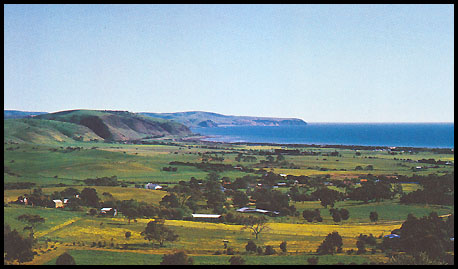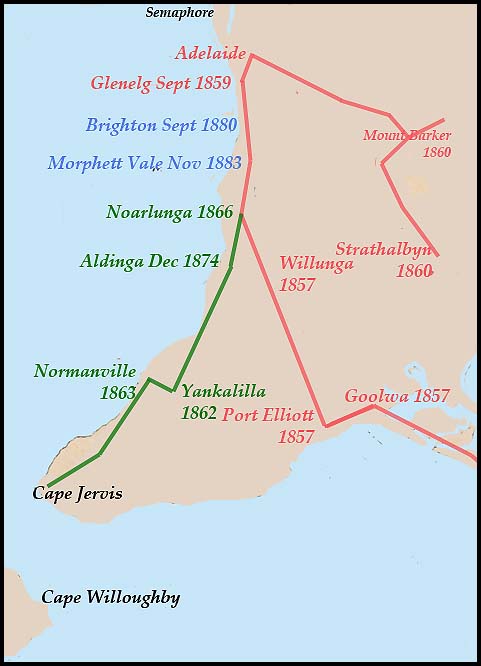Telegraph lines from Adelaide to the south.
- Site home & details
- Australia 1901-1988
- New South Wales
- Queensland
- South Australia
- Tasmania
- Victoria
- Western Australia
- International
- Special aspects
Lines to the south of Adelaide extended along the coast of the Gulf of St Vincent. There were two main components:
the line to the south on the mainland;
- the line on the mainland south via Willunga as far as Cape Jervis with branch lines to the coast;
- the lines to and on Kangaroo Island;
Line to the South.
One gentleman on the Corio had arranged that the messenger should await his arrival at the pier head where he threw him his packet before anyone had landed. Meanwhile two boats' crews had boarded the Corio, and one, under Mr. Y. W. Hodges, was ashore and its despatch sent forward more than a minute before the jockey from the pier had mounted his horse. Two others followed and a desperate race ensued to the (Adelaide) telegraph office but the leading jockey maintained his advantage and accomplished the six miles in 16 minutes. They came in as follows: — The Register's horse (Powning), 1; Mr. Sinnett's horse (Jewell), 2; Advertiser's horse (Hay), 3; Mr. Chubb's horse (R. George), 4. Powning had a second horse at the Morphett Arms; a third awaited him at Baker's Halfway House but he declined dismounting. The fourth was near to the boundary of the park lands and of this he availed himself. Jewell was l½ minutes behind and nearly lost second place by his horse shying towards his stable. Mr. Hay was there almost immediately afterwards with George a little behind. Not more than 3 minutes elapsed between the arrival of the first and fourth horses. The whole of the press messages transmitted to Victoria contained 7,000 words".
To avoid the necessity for "the absurd (and to the newspapers costly) jockeying which has been in existence for the last three months" (as noted by Todd in his 1859 Report) "a branch line has been carried down to Glenelg close to the pier, at which the mail is landed. The race, if race there is to be, will therefore be confined to the short distance between the pier and the telegraph office".
Clearly the mail race was abandoned. Nevertheless the continuing importance of the mail deliveries - now using the telegram - was underlined in the note in the Argus on 8 March 1860: "The arrival of the mail steamer at Nepean Bay was reported soon after the close of business this afternoon but up to midnight no telegram of the English news had been received. The usual signal to notify that the mail had arrived at Nepean Bay was hoisted at the Telegraph office but it appears that this was done on a rumour that the mail steamer had been seen in Investigator Bay".
Yankalilla and Normanville.
| Soon after, a branch line was extended to Yankalilla and Normanville in the far south. It is unclear as to where this branch left the No. 1 line but it appears it would have been from Port Elliott. The connection to these two places was in keeping with Todd's aim to access Cape Jervis and thence Kangaroo Island. It would be another 16 years before Todd could think of extending the telegraph lines to Kangaroo Island via the Yorke Peninsula. The House of Assembly approved the expenditure for the line to Yankalilla on 5 August 1861. The opening was in 1862 but another Telegraph Office opened close by at Normanville the following year. Normanville was a port from which the district's wheat and corn were exported. |  A recent view over Normanville south-west to the Spencer Gulf. Note the absence of pirate ships. |
Many people were puzzled by the choice of Yankalilla in the first place. For example, part of a letter to the Editor of the South Australian Register of 11 March 1862 said: "It is rumoured generally that the station is fixed for Yankalilla and not at Normanville. This appears very strange to all, I think, who are not personally interested in the township of Yankalilla.We think it requires no argument to show that the Telegraph Office ought to be as near the coast as possible, especially in such a place as Normanville. We remember that Normanville is the outlet and inlet, not of a part, but of the district at Normanville.
The Police Station, the Sub-Collector of Customs Office, the Local Court, the District Council Office, the connecting Post-Office with Finniss Vale, are at Normanville, as also are the principal corn stores. It must be known, too, that all the imports or exports must come to this point. It seems singular, indeed, that in view of all this, the office should stand at least two miles from these establishments and more so at such a moment when all watchfulness is required on the seas. For my own part, I confess I shall not believe the Government will act so blindly until I see it. It should be remembered that the main line of road to Cape Jervis touches Normanville, and that the line to Port Elliot is incomplete except it reach to Normanville, the port of Yankalilla".
There was also a public meeting held on 4 March 1862 at Normanville. One of the most cogent reasons suggested at that meeting for having a telegraph office at Normanville (for the port) and not at Yankalilla was:
"the extreme probability that a war with America was at that moment in progress, that the inhabitants of Normanville knew not the moment when the crew of a privateer might land on their coast, rifle their homes, subject their relatives to dishonour and themselves to injury, perhaps to death. Such a catastrophe, with the station where it was at present, was not only possible but probable, for the enemy would come as a thief in the night; they were not likely to give warning of their approach. Were, then, the inhabitants of the seaport (Normanville) to abandon their families to the tender mercies of pirates while they ran a distance of two miles to telegraph their deplorable condition to the metropolis?".
It must have been a relief when the Telegraph Office opened in Normanville in 1863. Indeed, in the history of the Advertiser, there is only one story which has been published of an attack on Adelaide or on the places to the south.
Noarlunga and Aldinga
Telegraph Offices along the coast between Glenelg and Normanville were opened partly to service the port facilities at these places. The lines to each were branch lines from the main No 1 line. A branch telegraph line to Noarlunga was opened by Mr. Todd on 5 April 1866. To send the congratulatory messages as well as a few private telegrams, Todd used a portable battery which he had brought with him.
Another branch line was constructed to Aldinga from Willunga (3 miles away). The Post & Telegraph office opened on 19 October 1885. Unfortunately, three years later, a major incident occurred which raised questions about operational procedures:
South Australian Register
18 July 1888.
TELEGRAPH ARRANGEMENTS AT ALDINGA.
"Some enquiry has been made as to the delay in conveying the news of the wreck of the Star of Greece. The first news was received in Adelaide at 9.20 on Friday morning, while the vessel struck at 3 a.m. Of course the delay in communicating the information was mainly due to the ignorance of the people on shore up to 7 o'clock, when the vessel was first noticed off the beach. As soon as possible, a messenger went to the Aldinga Telegraph Office, about a mile distant, reaching there at 8 o'clock. The telegraph station mistress was roused, and tried to get off a message conveying news of the disaster but, owing to Aldinga being a sub-station off the main line, and only able to speak Willunga (which is a little over 3 miles distant) when in circuit between 9 a.m. and 8 p.m., she was unsuccesful. An attempt was made by the operator to get a special messenger to go to Willunga, but all the people were hurrying to the scene of the disaster, and the first message did not get to Willunga— the repeating station to Adelaide — until after 9 o'ciock.
The Minister of Education (Hon. J. C. F,. Johnson) has been informed that the amount of work done at Aldinga does not warrant it being on the main line, and the instrument there is a very old magnetic machine, quite incapable of any fast work with the best operator in the colony. If there had been a telephone attachment, the message would have reached Willunga an hour earlier".
Although these places were each in the same general area, the terrain was difficult for transporting produce, etc overland.
Brighton and Morphettvale
The need to facilitate the quick transmission of news also led Todd to consider carrying the line to Kangaroo Island. With such a line, there would be no necessity for journalists or merchants to send special messengers to meet the mail at Nepean Bay (on the north-east corner of Kangaroo Island). All telegraphic advices on board the P&O vessels could be put into a separate mail-bag and landed at once at the station on Kangaroo Island and then be forwarded directly by the telegraph clerk.
As early as 1858 there were suggestions about the benefits of constructing a telegraph line to Port Jervis. For example, on 13 September, 1858 there was a note that the high land at Port Noarlunga (Onkaparinga) - Witton Bluff - commanded a view of the Gulf from the Lightship to Cape Jervis. It was therefore an admirably adapted location for a telegraph and lifeboat station, as vessels can approach it near enough to show their number distinctly.
After the telegraph line had been constructed through to Normanville in 1863, the original 1858 thoughts were replaced with a plan to extend the line to Port Jervis. Hence, in the 1866 Estimates, £1,200 was allocated for the construction of the line from Normanville to Cape Jervis.
It was not however until 26 August, 1872 that the South Australian Register was able to report:
THE CAPE JERVIS TELEGRAPH.
"It is gratifying to learn that the work of planting the poles for the telegraph from Normanville to the Cape Jervis lighthouse will be finished next week, Mr. Bradford, the contractor, having energetically carried on his task. When the wire is hung, the advantage of the line to the mercantile community will soon be apparent, for the movements of all vessels coming into Gulf St. Vincent from the eastward or going out through Backstairs Passage. It will then be possible to note and telegraph rapidly. As the wire will pass through Finnis Vale, the inhabitants are trying to get an office opened in that locality".
In March 1873, it was reported that the line to Cape Jervis and the telegraph station there "had been finished some time but are not being used".
This was the beginning of another important Todd project which recognised the importance of the seven lighthouses to the south of Adelaide. Part of this project involved opening up Kangaroo Island to the telegraph.
